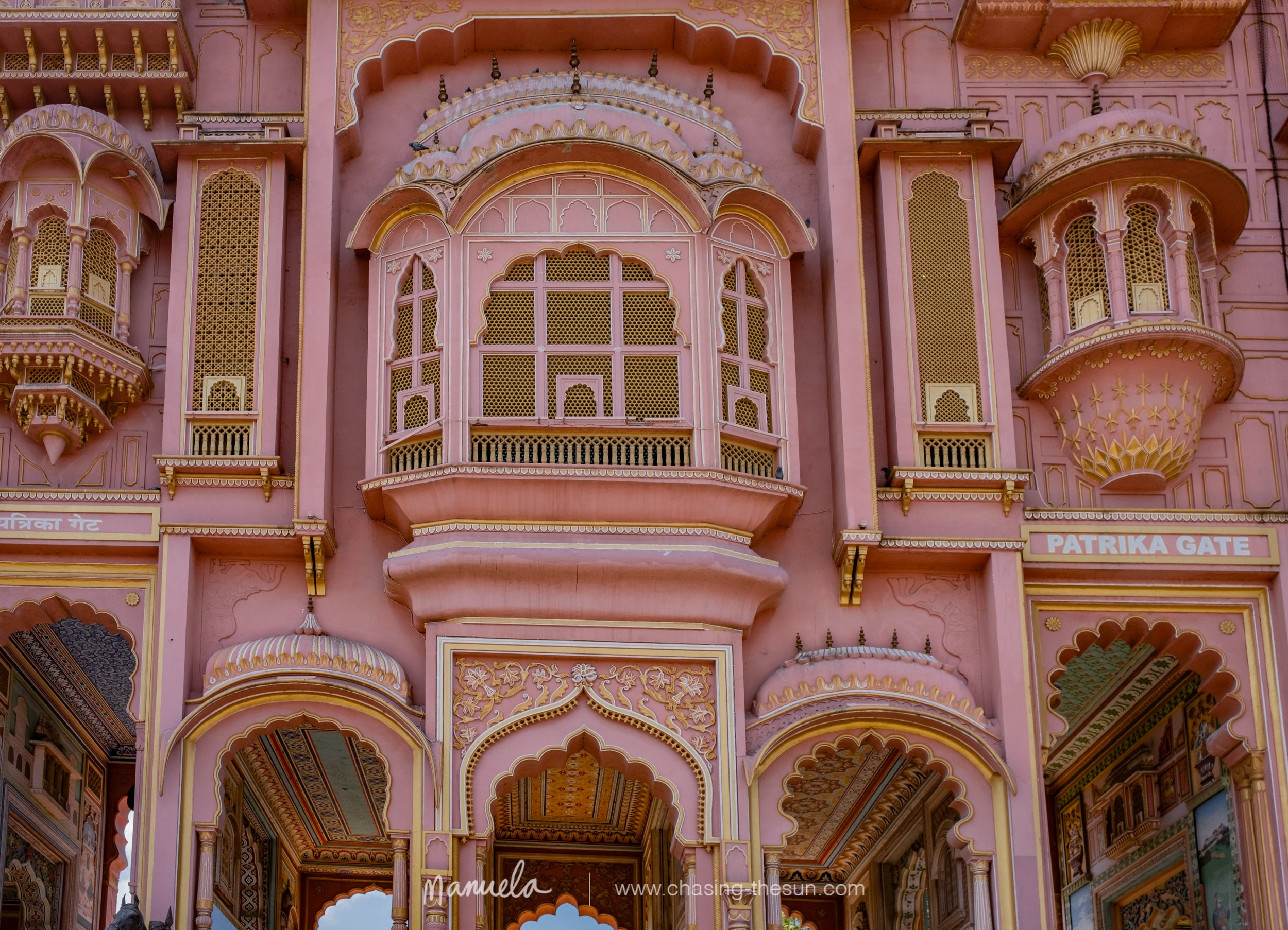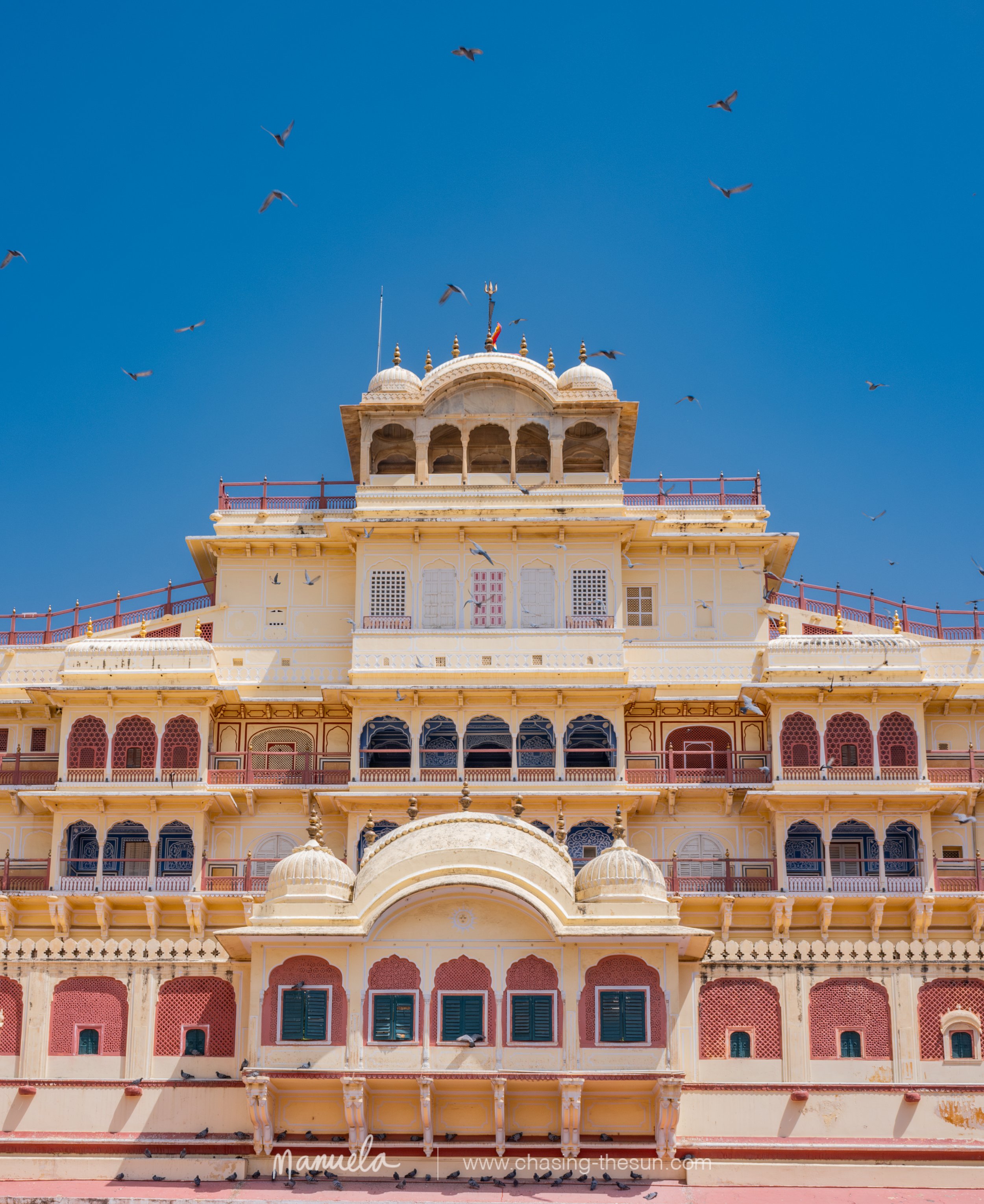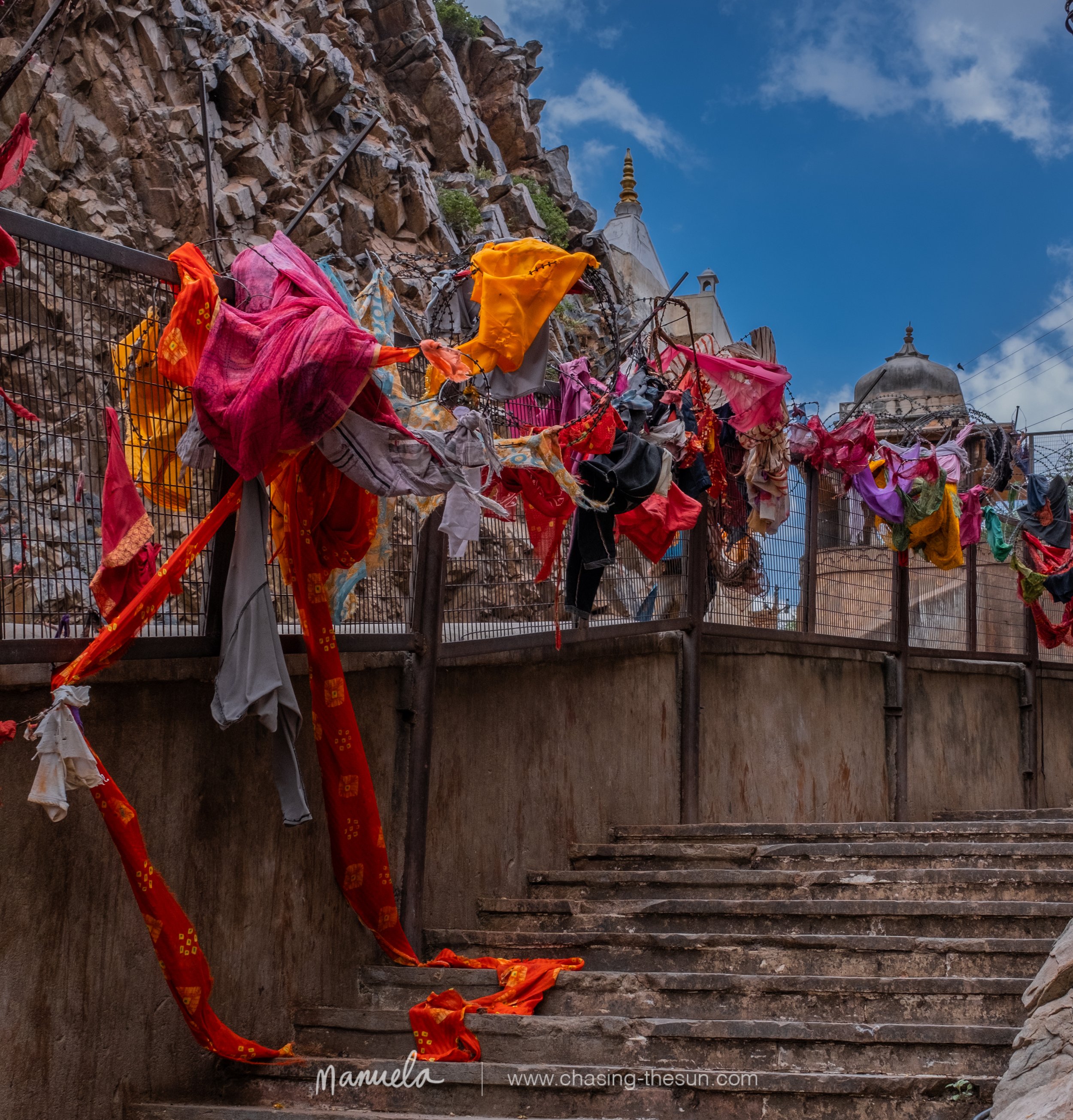
What to do?
1. Visit the iconic Hawa Mahal
Hawa Mahal, also known as the Palace of Winds, is an iconic architectural gem located in the heart of Jaipur, Rajasthan. This unique structure was built in 1799 by Maharaja Sawai Pratap Singh and is a stunning example of Rajput and Mughal architectural styles. Here's a virtual visit to the Hawa Mahal:
Approaching Hawa Mahal, one is immediately struck by its distinctive pink facade, a color that symbolizes the Pink City of Jaipur. The palace is a five-story building with an intricate honeycomb of 953 small windows, or jharokhas, adorned with latticework. These windows were designed to allow royal women to observe everyday life and festivities on the streets below while maintaining their privacy.
Upon entering the courtyard, the grandeur of Hawa Mahal unfolds. The architecture reflects the crown of Lord Krishna and is adorned with delicate floral patterns and geometric designs. The palace's name, Hawa Mahal, which translates to "Palace of Winds," is derived from the clever ventilation system created by the latticed windows, which allows cool breezes to circulate through the palace, making it an ideal respite during the scorching Rajasthan summers.
The historic significance and architectural beauty of Hawa Mahal make it a must-visit destination in Jaipur. It stands not only as a symbol of royal ingenuity but also as a testament to the rich cultural heritage of Rajasthan. Visiting Hawa Mahal transports you to a time of grandeur and elegance, allowing you to appreciate the fusion of art and practicality in this architectural masterpiece.
2. Go to Patrika Gate
Patrika Gate is known for its vibrant and intricate architecture, and it serves as the entrance to the Jawahar Circle garden. What sets it apart is its unique design, featuring a riot of colors and ornate detailing that showcases the rich cultural heritage of Rajasthan. The gate is a representation of various elements of Rajasthani culture, history, and traditions.
Each section of the gate is adorned with beautiful paintings, including depictions of historic forts, palaces, and traditional art forms. The color palette used in the artwork is lively and symbolic of the vibrant culture of Rajasthan. Visitors often appreciate the gate not only for its architectural beauty but also for the storytelling aspect of the paintings that represent the essence of the state.
Patrika Gate is a popular spot for both tourists and locals alike who seek to capture the beauty of this cultural landmark. It serves as a backdrop for many photographs and is considered a visual treat for those interested in art, architecture, and the cultural heritage of Rajasthan.
When visiting Jaipur, exploring Patrika Gate offers a unique and colorful experience, allowing you to immerse yourself in the cultural richness and artistic expression that the city is known for. Always check for any updates or changes to the site's accessibility and features, as tourism destinations can evolve over time.
3. Explore the royal landmarks of The City Palace
Chandra Mahal: The Chandra Mahal is the residence of the current Maharaja of Jaipur. While most of the palace is not open to the public, visitors can explore a part of it that has been converted into a museum. The museum exhibits a remarkable array of royal artifacts, including rare manuscripts, weapons, carpets, and paintings.
Pitam Niwas Chowk: The Pitam Niwas Chowk is a courtyard that leads to the private chambers of the Chandra Mahal. It is adorned with beautiful gates representing the four seasons. Each gate is dedicated to a different Hindu deity, and the intricate details reflect the cultural and religious influences on the palace's design.
Diwan-i-Khas and Diwan-i-Aam: These are two important structures within the City Palace complex. Diwan-i-Khas, or the Hall of Private Audience, was where the Maharaja met with important guests. Diwan-i-Aam, or the Hall of Public Audience, was where he addressed the general public.
A visit to the City Palace provides a captivating journey through Jaipur's royal history. The stunning architecture, impressive artifacts, and the overall ambiance make it a must-visit destination for those interested in the rich cultural heritage of Rajasthan.
The City Palace in Jaipur is a magnificent complex that stands as a symbol of the royal heritage and grandeur of the Pink City. Built in the 18th century by Maharaja Sawai Jai Singh II, the founder of Jaipur, the City Palace is a fusion of Rajput, Mughal, and European architectural styles. It serves as both a royal residence and a museum, showcasing the rich history and cultural legacy of Jaipur.
Here's a glimpse of what you might experience during a visit to the City Palace:
Architectural Marvels: The City Palace is a vast complex with courtyards, gardens, and buildings. The architecture is a delightful blend of red and pink sandstone and marble. The intricate carvings, lattice work, and decorative elements reflect the craftsmanship of the artisans of that era. The Chandra Mahal and Mubarak Mahal are two prominent palaces within the complex, each offering a unique architectural style.
Mubarak Mahal: The Mubarak Mahal, which translates to the "Auspicious Palace," is a stunning building that was originally built as a reception center. Today, it houses the Maharaja Sawai Man Singh II Museum. The museum displays an impressive collection of royal costumes, textiles, and artifacts, providing a glimpse into the opulent lifestyle of the erstwhile Maharajas of Jaipur.
4. Visit the Unique Monkey Temple
The "Monkey Temple" in Jaipur is more formally known as Galta Ji Temple. This ancient Hindu pilgrimage site is situated amidst the Aravalli Hills, about 10 kilometers east of Jaipur's city center. The temple complex is dedicated to the Hindu god Hanuman and is colloquially referred to as the Monkey Temple due to the large population of monkeys that inhabit the area.
Here are some key aspects of the Galta Ji Temple:
1. Hanuman Temple: The main attraction of the Galta Ji Temple is the Hanuman Temple, dedicated to Lord Hanuman, the monkey god. The temple is set amidst a series of temples and kunds (natural springs) that are part of the larger complex. The main temple, along with other smaller shrines, is beautifully adorned with paintings and carvings.
2. Natural Springs (Kunds): The Galta Ji Temple complex is known for its several freshwater springs, or kunds, which are believed to have sacred and healing properties. Among these, the Galta Kund is the most revered. Pilgrims and visitors often take a ritual dip in the kunds as part of their religious practices.
3. Architecture and Surroundings: The temple complex is nestled within the folds of the Aravalli Hills, offering panoramic views of the surrounding landscape. The architecture of the temples reflects traditional Rajasthani style, with intricate carvings and vibrant colors.
4. Monkey Population: The Monkey Temple is famous for its resident monkey population, which freely roams around the temple premises. Visitors often find these monkeys to be a playful and entertaining aspect of the visit, although it's advisable to exercise caution and not feed them.
5. Religious Significance: Galta Ji Temple holds immense religious significance, especially for followers of Lord Hanuman. The temple complex is considered sacred, and many devotees visit it to seek blessings, particularly during special religious occasions and festivals.
6. Sunset Point: The temple complex also provides a picturesque view of the city of Jaipur, making it a popular spot for both pilgrims and tourists. The site is particularly beautiful during sunset, offering a tranquil and spiritual atmosphere.
Visiting the Monkey Temple provides not only a spiritual experience but also an opportunity to appreciate the natural beauty and cultural heritage of the region. The combination of religious fervor, architectural beauty, and the playful presence of monkeys makes Galta Ji Temple a unique and memorable destination in Jaipur.
5. Astronomical Observatory
The Jantar Mantar in Jaipur is an astronomical observatory and a UNESCO World Heritage Site that showcases the scientific and mathematical brilliance of ancient India. It was built by Maharaja Sawai Jai Singh II, the founder of Jaipur, in the early 18th century. The Jantar Mantar in Jaipur is one of several such observatories constructed by Jai Singh across India.
Here are some key features and aspects of the Jantar Mantar in Jaipur:
1. Architectural Marvel: The Jantar Mantar consists of a collection of nineteen architectural astronomical instruments. These instruments are made of stone and marble and are designed to measure time, predict eclipses, track stars' positions, and determine celestial altitudes and azimuths.
2. Sundial: One of the most iconic structures within the Jantar Mantar is the Samrat Yantra, or the Giant Sundial. This massive sundial, standing at 27 meters, is designed to give accurate time readings. It's considered one of the largest sundials in the world and can be used to measure time with an accuracy of about two seconds.
3. Other Instruments: The Jantar Mantar includes various other instruments like the Ram Yantra, Jai Prakash Yantra, and the Misra Yantra, each serving a specific astronomical purpose. These instruments showcase the advanced understanding of astronomy and mathematics during the Mughal period.
4. Astronomical Significance: The observatory was constructed with the purpose of making highly accurate astronomical measurements. Jai Singh, a scholar and ruler, was passionate about astronomy and sought to create a state-of-the-art observatory that could rival contemporary observatories in Europe.
5. Unique Structures: Each instrument at the Jantar Mantar has a unique design and serves a specific purpose. The structures are often massive, with intricate markings and engravings. Visitors can explore these instruments and learn about the scientific principles behind them.
6. Educational Value: Today, the Jantar Mantar serves not only as a historical site but also as an educational destination. Visitors can participate in guided tours to understand the functioning of each instrument and gain insights into the astronomical knowledge of the past.
6. Visit Local Fabric Artisians
Visiting local fabric artisans in Jaipur is an immersive journey into the heart of Rajasthan's rich textile traditions. Start your exploration in the vibrant markets of Johari Bazaar and Bapu Bazaar, where the kaleidoscope of colors and patterns beckons. These bustling markets are a treasure trove of fabrics, showcasing the exquisite craftsmanship of local artisans. Wander through the narrow lanes to discover small workshops and stalls, each telling a story of handwoven fabrics, block printing, and traditional tie-dye techniques. Engage with skilled artisans who passionately create intricate designs using wooden blocks or demonstrate the delicate art of hand embroidery. The energy and creativity that permeate these markets offer a firsthand experience of the age-old techniques that have defined Jaipur's textile landscape for centuries.
For a deeper understanding of the craft, venture to the Sanganer village on the outskirts of Jaipur. Here, the air is filled with the rhythmic sounds of block printing, and artisans invite you to witness their intricate work. The Sanganer village is a hub of traditional hand block printing, where artisans meticulously carve wooden blocks and apply vibrant dyes to create stunning patterns on fabrics. Many workshops in Sanganer also provide immersive experiences, allowing visitors to try their hand at block printing under the guidance of skilled craftsmen. This hands-on encounter with the fabric-making process enhances appreciation for the artistry involved and provides a unique memento of your visit to the vibrant textile hub of Jaipur.
7. Visit Nahargarh Fort
Nahargarh Fort, perched on the Aravalli Hills overlooking the Pink City of Jaipur, is a historic fortress that has played a significant role in the defense of the region. Built in 1734 by Maharaja Sawai Jai Singh II, the founder of Jaipur, Nahargarh Fort is part of the trio of forts, along with Jaigarh Fort and Amer Fort, that collectively guarded the city.
The fort's strategic location provides breathtaking panoramic views of Jaipur, making it a popular destination for both history enthusiasts and tourists seeking stunning vistas. The name "Nahargarh" translates to "Abode of Tigers," and according to legend, the fort was named after Nahar Singh, a prince whose spirit supposedly haunted the area during the fort's construction.
The architecture of Nahargarh Fort is a blend of Indian and European styles, with impressive structures like Madhavendra Bhawan standing out. Madhavendra Bhawan is a palace within the fort complex, comprising suites for the king and his queens. The layout includes interconnected suites, providing separate quarters for each queen.
Beyond its architectural beauty, Nahargarh Fort has historical significance. During the Indian Mutiny of 1857, the fort served as a refuge for Europeans. The fort's walls and bastions still bear witness to the events of that period.
Today, Nahargarh Fort is a popular destination for locals and tourists alike. The fort is accessible by a winding road or a trek through the Aravalli Hills, offering a choice between a scenic drive or an adventurous hike. The fort's ambiance, historical charm, and panoramic views make it an ideal spot to explore Jaipur's past while enjoying the natural beauty that surrounds the Pink City. Visitors can stroll through the courtyards, climb to the battlements, and absorb the cultural and historical richness that Nahargarh Fort embodies in the vibrant tapestry of Jaipur's heritage.
8. Discover the Amber Fort and Palace
The Amber Fort, also known as Amer Fort, is an architectural marvel nestled on a hilltop, overlooking Maota Lake on the outskirts of Jaipur, Rajasthan. Constructed in the 16th century by Raja Man Singh I, the fort is a splendid example of Rajput architecture and is renowned for its majestic blend of Hindu and Mughal styles.
The fort's exterior is an imposing facade of yellow and pink sandstone, adorned with intricate carvings, frescoes, and mirror work. The grand entrance, Suraj Pol (Sun Gate), opens into the main courtyard where the beauty of the fort unfolds. Visitors can ascend to the fort by walking, taking an elephant ride, or by a vehicle. The Elephant Gate (Hathi Pol) is particularly iconic, where elephants once carried royalty into the fort.
One of the notable features of Amber Fort is the Diwan-i-Aam, or the Hall of Public Audience, which boasts an array of beautifully carved pillars. The Diwan-i-Khas, or Hall of Private Audience, showcases delicate mirror work and exquisite floral patterns. The Sheesh Mahal, or the Palace of Mirrors, is a dazzling chamber adorned with countless reflective glass pieces that, when lit, create a starry illusion.
The fort also houses the Sukh Niwas, or the Hall of Pleasure, with its unique cooling system. The palace's design allowed water to flow through channels, creating a natural air conditioning effect. The Zenana, or women's quarters, are a series of rooms intricately designed for the queens, each reflecting a distinctive charm.
The Amber Fort's hilltop location affords panoramic views of the surrounding landscapes, Maota Lake, and the city of Jaipur. The fort's strategic positioning not only provided a defensive advantage but also contributed to its aesthetic appeal.
Visitors to Amber Fort can immerse themselves in the historical grandeur, marvel at the architectural brilliance, and appreciate the fusion of Hindu and Mughal artistic elements. The fort's timeless beauty and cultural significance make it a must-visit destination for those exploring the regal heritage of Jaipur and Rajasthan.
9. Panna Meena ka Kund
Panna Meena ka Kund is a historical stepwell located in the Amer region near Jaipur, Rajasthan, India. This ancient stepwell, also known as Panna Mian ki Baori, was built during the sixteenth century and served both as a practical water conservation solution and a place for the community to gather.
The stepwell is an architectural marvel with a symmetrical design, featuring crisscrossing stairs on three sides that lead down to the water level. The fourth side is adorned with arched niches and chambers. The intricate geometric patterns and carvings on the steps and walls make Panna Meena ka Kund a visually captivating structure.
Apart from its functional purpose of storing and conserving water, Panna Meena ka Kund served as a communal space where locals gathered for socializing and daily chores. The stepwell also played a role in rainwater harvesting, allowing the community to manage water resources efficiently.



























